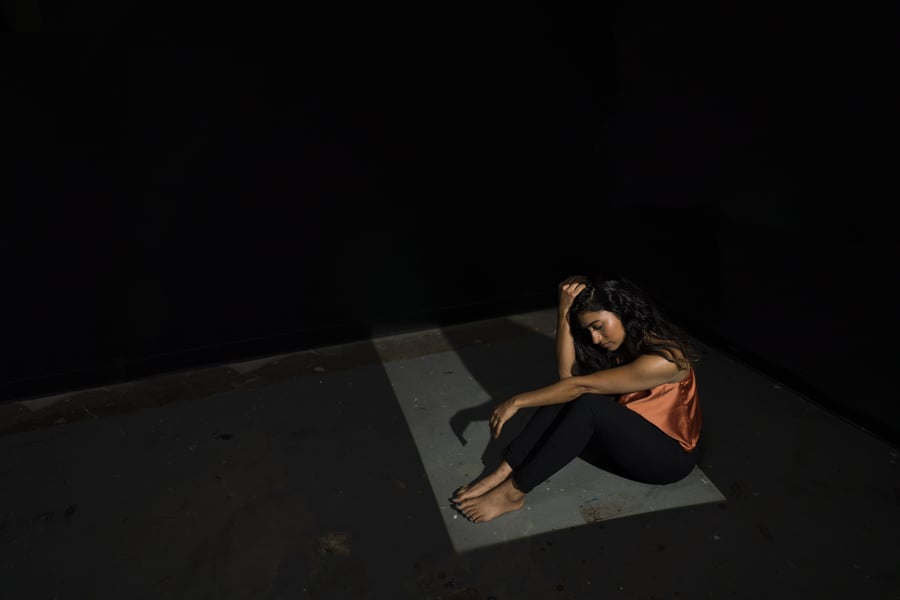Set Them Free: Catholics continue the long battle against human trafficking

Editor's Note: The images accompanying this article are not of an actual trafficking victim. They are in-studio photos meant to illustrate the journey of a trafficking victim from slavery to freedom and healing. (NTC/Juan Guajardo)
Sara* crossed the makeup store with blush and a lipstick in her pocket. She hoped to be able to leave the place without raising suspicion. Due to her precarious financial situation, by the time she was 13 she had already stolen food, soap, and deodorant from a supermarket. This time, however, the metal detector gave her away, and in the blink of an eye, a police officer was standing right in front of her.
The police officer discovered the girl didn´t live with her family, but in a hotel with her boyfriend, a rather older man, and another girl about her same age, whom she identified as her sister, even though they were not biologically related. Sara’s background check quickly showed it was not a mere case of petty theft: the girl had missed school for the past three weeks, and she had escaped the Child Protective Services system, where she had arrived after being sexually abused by her uncle on numerous occasions. Now she was in the hands of a trafficker who sold her for sexual services.
Sara was placed under the care of therapists in Denton County, although many victims of human trafficking are frequently treated as criminals — either because they are forced to recruit other girls the same age or because they commit other minor crimes related to their struggle to survive.
“Pimps and people who sell minor children take advantage of the complexities of the criminal justice system to manipulate them and make them believe they are responsible for their situation, and that they could go to jail if they report them,” said Kristen Howell, Executive Director of the Children’s Advocacy Center for Denton County.
“Children feel ashamed, they don’t perceive themselves as victims, but as accomplices; this is precisely one of the main things that impedes justice and healing,” she added.
Human trafficking has been considered a crime in the United States only since 2000. The most recent statistics obtained by Polaris, an organization which has operated the U.S. National Human Trafficking Hotline for over a decade, reported 11,500 cases of human trafficking in 2019. In Texas that year there were more than 1,000 cases involving 2,455 victims. Nevertheless, this crime is notoriously underreported, and it is acknowledged that these statistics only show a fraction of the real problem.
According to the data collected by the Child Sex Trafficking Team of the Office of the Texas Governor Greg Abbott, currently 80,000 children are victims of human trafficking in Texas. The International Labor Organization estimates this crime affects over 40 million people. Seventy-seven percent of those people are trafficked within their country of origin, while 23 percent of them are taken beyond the borders of their home country.
“Human trafficking is the politically correct term for modern slavery,” said Dr. Kim Robinson, an expert psychologist in human trafficking, who around a year ago, with the support of the Safe Environment Office of the Diocese of Fort Worth, started holding workshops intended for parents, grandparents, teachers, members of the congregation, and caregivers to teach them how to identify warning signs in teenagers and children who could be human trafficking victims.
In recent years, the Catholic Church has redoubled its efforts to create awareness of this painful scourge. For instance, this January the Texas Catholic Conference of Bishops offered a toolkit of resources for Catholics to use during a Week of Prayer to End Human Trafficking. The U.S. Conference of Catholic Bishops has also developed a robust toolkit with ways that Catholics can raise awareness about human trafficking.
“It is important for people to understand that the main motivations of traffickers are money and greed. We need to hit them where it hurts most, which is their finances. A $10,000 bail for one of those guys to get out of jail is a joke,” Robinson said.
The average human trafficker makes about $12,000 a week for every trafficked girl in the Dallas-Fort Worth area. If he exploits three girls every week, his profits can reach almost $2 million per year.
Experts explain that the Dallas-Fort Worth area is considered an epicenter of human trafficking, the second biggest in Texas after Houston. The reasons for this sad reality are geographic and commercial: Interstate 35 allows easy transportation of victims from one state to the other. Conventions, big sports events, and concerts, which attract people from all over the country, are factors that exacerbate this forced prostitution.

Speak: "Speak up for those who cannot speak for themselves, for the rights of all who are destitute." - Proverbs 31:8-9 (NTC photo illustration/Juan Guajardo)
“A human trafficker once said in court: ‘If I buy drugs, they can be used just once, but a human being can be sold again and again and make much more money,’” Robinson recalled. “Drugs are undoubtedly used in sexual trafficking to intimidate victims or to make them participants of acts they do not want to perform. Substance abuse, which in the long run endangers their lives, makes them very dependent on the trafficker.”
In the 90-minute workshops offered via Zoom, Robinson asks adults and parents to be alert to behaviors that could indicate their children are being exploited: absences from school, isolation from family, and new friends and habits. Other warning signs are access to luxury items such as cellphones, designer clothes, expensive shoes or bags, and wearing sexually provocative outfits.
Since young people are frequently recruited by gangs, they could start getting tattoos or suffer from unexplained injuries. Although the typical case includes a pimp with an average age of 28 who seduces a girl by promising that he will make her an actress or a model (70 percent of human trafficking victims are female, according to the International Labor Organization’s statistics), males are also victims of human trafficking.
The average recruitment age is 12-14 in the case of girls, and 11-13 for boys. Even though the crime is not restricted to a particular ZIP code or racial origin, FBI data shows that it mostly affects Black, Hispanic, or LGBT minorities, who are already on the margins of society due to discrimination and poverty.
“We know our children well and we can tell if something is bothering them. We realize if they are depressed or anxious, if they are not eating or if they eat too much,” Robinson added. “It is important to monitor their social media, since during the pandemic this has become the main focus of pimps to attract children. Just by looking at their profile, a criminal knows what school they go to, whom they hang out with, where they live, and where they practice sports. It is very easy for predators and human traffickers to become part of the lives of the children and young people they seek and harass.”
Some applications such as NetSmartz, which was developed by the National Center for Missing & Exploited Children, educate parents and their children on internet safety while using games, videos, and interactive activities. Other applications, such as Qustodio, provide parents with several smart tools to help supervise the sites that children visit and block any questionable sites.
Trauma and Punishment
Once the victims are rescued from the network of pimps, their path to healing is long and complicated. The World Health Organization diagnoses the emotional and mental consequences of these victims, who have been exposed to threat and punishment on a daily basis, as “complex trauma.” Many have developed depression, anxiety, obsessive compulsive disorder, and post-traumatic stress.
“Many victims have had adverse childhood experiences, but have not received any kind of justice in their case, and the abuse they have been through becomes normalized,” said Howell, from the Children’s Advocacy Center.
“This trauma is devastating for the brain of a child during his or her development. It breaks their capacity to acknowledge that they were hurt by another person,” Howell added.
Even though few cases are brought to trial before the judicial authorities, the way this crime is perceived today has changed, partly thanks to the educational training carried out by different civil society organizations. Federally, these training sessions are mandatory in every agency, but to date in Texas they only reach mental health professionals and hospital workers, who are trained to recognize the signs and symptoms both in the victim and the trafficker, and to know how to proceed in case of suspicion.

Lift: "I waited patiently for the Lord; He turned to me and heard my cry. He lifted me out of...the mud and the mire." -Psalm 40:1-2 (NTC photo illustration/Juan Guajardo)
“When we didn’t understand very well the crime of human trafficking, women were arrested for prostitution regardless of their age. Now, we put them in touch with therapists and organizations that give them shelter while we chase the real predators,” said Felicia Grantham, Human Trafficking Coordinator of the Fort Worth Police Department. She belongs to the Tarrant County Five Stones task force, a community network created in 2014 that comprises 27 agencies engaged in ending minor sexual trafficking in the area.
“Recovery is a long and complex process. It takes a long time for the victims to get out of their own situation because sometimes the trafficker provides everything for them. Therapy can go on for the rest of their lives, due to all the things that the victims need to process and overcome,” Grantham added.
If it is safe, children can go back to their families, but they frequently go to residential centers or they enter the foster care system. They often need outpatient care, or immediate hospitalization, in cases of severe exploitation. It is a big challenge for these children and youth to rebuild confidence in adults, Grantham said.
Sanctuary for the Victims
A space designed to that end is Ranch Hands Rescue, where psychologist Robinson works. Through horses, ponies, goats, donkeys, pigs, and sheep, victims learn how to connect with animals and gradually regain confidence in their own instinct to evaluate uncertain and unsafe situations.
The sanctuary, located in Argyle, which is north of Fort Worth, will serve as one of the first safe houses for 18 to 25-year-old men who have been victims of human trafficking. It is expected to open on May 1 this year. “They can stay from one to three years so they can recover emotionally and learn how to behave in normal work environments,” Robinson stated. “They can pursue an education if they wish to do so.”
The diocesan Office of Safe Environment has a victim assistance hotline, 817-945-9345, to deal with cases of sexual abuse, cyber bullying, or any case of child neglect which may occur in parish schools or any other facilities of the diocese.
Safe Environment Director Sandra Schrader-Farry explained that in the last year, strong efforts have been made to educate and focus on the human trafficking problem.
“Bishop Olson has said that ‘child trafficking is an evil that comes from darkness.’ This tragic problem calls all of us who live in the Metroplex into action,” said Schrader-Farry. “People have the wrong idea that this is something that happens elsewhere or that requires violent acts such as kidnapping, and that is not the case. Traffickers seduce their victims with charismatic personalities, and then they make them dependent.”
Bishop Michael Olson is a strong supporter of the awareness workshop hosted by the Office of Safe Environment which shines light on the issue.
“Interstate 35 and Interstate 20, which intersect in our diocese, are two major thoroughfares of the trafficking of human beings for the sex trade,” Bishop Olson said. “Thus, it is absolutely our imperative for Catholics in our diocese to learn how to recognize these signs and protect vulnerable children from being abused and harmed.”
He added, “When I met with Pope Francis and the Texas bishops in Rome in January 2020, he told us that the greatest evil the Devil is perpetrating today is human trafficking. He told us that we must lead our people in the fight against this evil as faithful successors of the apostles of Christ.”
In addition to the awareness workshops, Safe Environment has a “confidential notice of concern” form which is accessible to all members of the diocese and the community. It allows individuals to report anonymously or confidentially any incident or suspicion of physical, sexual, or emotional abuse.

Redeem: "Fear not, for I have redeemed you; I have called you by name: you are mine." -Isaiah 43:1 (NTC photo illustration/Juan Guajardo)
“If there are kids in our parish who could be in a dangerous situation, we can start an investigation,” affirmed Nancy Mitchell, assistant director of Safe Environment. “This form can help them put the facts in order. They can come to us even before going to the police because sometimes, if there are other victimized minors in the family, the fear is too great.”
It’s not just the local Church that has been fighting against the scourge of trafficking. Robinson said the U.S. bishops’ Anti-Trafficking Program for more than a decade “has been a leader in the U.S. and global response to human trafficking.”
Under that umbrella, the USCCB leads several other efforts that span from raising awareness and advocacy to re-integration and employment services for victims of trafficking.
On a global scale the Church has continued its historic fight against trafficking too. Since 2013, his first year as pope, the Holy Father has made fighting human trafficking a priority.
In 2018, after meeting with a young trafficking victim at a papal audience, Pope Francis got to work and instructed the Vatican’s Migrants and Refugees Section (which he established in 2017) to address modern slavery and human trafficking.
What resulted was a comprehensive pastoral guide offering orientation on how to combat the “ugly business” of the $150 billion human trafficking industry which knows no borders and has extended beyond forced labor and sex to trafficking in newborn babies, women for forced surrogacy, and human organs. Titled “Pastoral Orientations on Human Trafficking,” the handbook, which is used by Catholic dioceses and organizations as well as civil agencies, analyzes human trafficking from several angles and provides recommendations ranging from identifying and reporting trafficking to aiding in the spiritual and psychological recovery of its victims.
A Long Path to Healing
Victims of sex trafficking have a patron in Saint Josephine Bakhita, whose feast day is celebrated on February 8. Josephine Bakhita was a 19th-century saint who was captured in Sudan by Arabic slave traffickers when she was 8 years old. During her lifetime, she was bought and sold five times and forced to serve rich families who put her in chains, whipped her, and even once inflicted 114 wounds in order to tattoo a property symbol on her. Eventually, she was placed in the care of the Canossian Sisters in Italy who, along with the cardinal of Venice, intervened on Josephine’s behalf in court. A judge concluded that she was free, and she joined the community of religious sisters. Her faith and service, plus courageous action by compassionate Catholics, were key to her freedom and recovery.
Abused children have a complex spiritual dynamic, because when they escape they can feel protected by a God who helped them to break free, but they can also have a feeling of abandonment when they are going through their worst moments of torture. As with St. Bakhita, Catholics have a critical role to play.
“This is one of the most complex crimes that has been occurring since biblical times,” Howell observed. “It is very important that the Church provide a place for children to recognize that they are not invisible, but beloved and worthy sons and daughters of God. That is how they can experience the path towards their emotional and spiritual healing.”
*Editor’s Note: The victim’s real name was changed in order to protect her identity.
